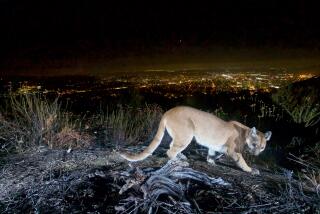City Students Get Animal-Eye View of Wild
- Share via
When a busload of children from Manhattan Place Elementary School arrived at Malibu Creek State Park in Agoura on Tuesday, Ranger Mikal Sandoval jumped on board and divided the 63 fifth- and sixth-graders into “lizards” and “bobcats.”
“You are now lizards and that means you are silent,” Lenora Bork, a Manhattan Place science teacher, instructed the first group to leave the bus.
Taking her at her word, 32 “lizards,” 9 and 10 years old, quietly lined up outside, ready for the first statewide Junior Park Ranger Field Trip.
About 1,600 children from around the state gathered Tuesday at four parks--in San Diego, Sacramento, San Francisco and Agoura--for the event, designed by the state Department of Parks and Recreation to teach schoolchildren about plants and wildlife and to make them more aware of state parks.
Effort to Boost Attendance
The Junior Park Ranger event is one element of the “Pop Into a Park” program, a new state effort sponsored by Pacific Bell and Post cereals to increase off-season attendance.
“The traditional time people come to the parks is between Memorial Day and Labor Day,” Sandoval said. “We’re looking for people to come in non-traditional times.”
The children from Manhattan Place Elementary School on West 98th Street were among 389 from eight Los Angeles-area schools who gathered at the Malibu Creek park Tuesday. Each school’s delegation was divided into different animal groups and led off by rangers to look at willows, walnuts or oaks and, if lucky, to catch a glimpse of deer or quail.
Most of the Manhattan Place youngsters had never been in the mountains before, Bork said. Even before arriving, they were amazed as they stared from the bus at the areas of Malibu Canyon burned in last week’s fire.
Reassurance on Clouds
The morning clouds that lingered ribbonlike below the hilltops had seemed like smoke to the children, Bork said.
“They had to be reassured that it wasn’t fire,” she said.
John B. Schmill, supervising ranger of the Santa Monica Mountains District, took charge of the “lizards,” telling them that each group of children had to start the day by imitating its namesake.
Soon they were all on the ground, Schmill included, supporting themselves with their forearms, sticking their tongues out at imaginary insects and laughing.
“You’re the best lizards I’ve ever seen,” Schmill said, before leading them, upright, down a path he called a “natural deer trail.”
Among the things he showed them were willow trees whose bark had been scraped off by deer rubbing their antlers, a clearing where deer sleep and quail that rustled out of a thicket.
Odor of Leaves
Holding out a branch, he instructed the children to “take a leaf, crush it up and smell it.”
“Ugh!” Rae’chel Harris, 9, said, crinkling her nose.
Schmill told the students that their parents bought the same leaves in stores, and asked them to guess what they were. No one could.
“Bay leaves,” Schmill said. “It’s a food seasoning.”
The children played games organized by Schmill and Lesley Devine of the Las Virgenes Regional Conservation District to teach them about the food chain, the animals and the Chumash Indians who originally inhabited the area. Sherese Butler, 10, and Althenia Hill, 11, said they wished they could see more wild animals.
The animals were probably shy, they decided.
“They’re probably like my dog,” Althenia said. “He waits until everyone leaves the house, then comes out and goes crazy, rolling toilet paper around.”
“Next time I come, I’m going to bring a camera,” Sherese said.
Devine told her that that would be fun, particularly “if you see hawks.”
The child looked at her.
“What’s a hawk?” she asked.
More to Read
Sign up for Essential California
The most important California stories and recommendations in your inbox every morning.
You may occasionally receive promotional content from the Los Angeles Times.













